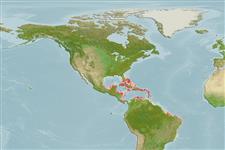>
Gobiesociformes (Clingfishes) >
Gobiesocidae (Clingfishes and singleslits) > Gobiesocinae
Etymology: Acyrtus: Greek, a = without + Greek, kyrtos, -e, -on = bent + Greek, ops = shape (Ref. 45335).
More on author: Poey.
Environment: milieu / climate zone / intervalo de profundidade / distribution range
Ecologia
marinhas bentopelágico; intervalo de profundidade 0 - 4 m (Ref. 26938). Tropical
Western Atlantic: Bahamas and the Greater and Lesser Antilles. Grand Cayman, Isla de Providencia, western Caribbean from Mexico to Honduras (Ref. 26938).
Tamanho / Peso / Idade
Maturidade: Lm ? range ? - ? cm
Max length : 3.5 cm TL macho/indeterminado; (Ref. 5521)
Descrição breve
Chaves de identificação | Morfologia | Morfometria
Upper lip widest at middle; no papillae in central part of disk (Ref. 26938).
Body shape (shape guide): elongated.
Lives in close association with the sea urchin Echinometra mainly for protection. Feeds primarily on benthic crustaceans like amphipods, but harpacticoid copepods and ostracods are also eaten (Ref. 33548).
Life cycle and mating behavior
Maturidade | Reprodução | Desova | Ovos | Fecundidade | Larvas
Böhlke, J.E. and C.C.G. Chaplin, 1993. Fishes of the Bahamas and adjacent tropical waters. 2nd edition. University of Texas Press, Austin. (Ref. 5521)
Categoria na Lista Vermelha da IUCN (Ref. 130435: Version 2025-1)
Ameaça para o homem
Harmless
Utilização humana
Pescarias: sem interesse
Ferramentas
Relatórios especiais
Descarregue XML
Fontes da internet
Estimates based on models
Preferred temperature (Ref.
123201): 26.4 - 28.2, mean 27.5 °C (based on 497 cells).
Phylogenetic diversity index (Ref.
82804): PD
50 = 0.5312 [Uniqueness, from 0.5 = low to 2.0 = high].
Bayesian length-weight: a=0.00617 (0.00250 - 0.01521), b=3.15 (2.94 - 3.36), in cm total length, based on LWR estimates for this (Sub)family-body shape (Ref.
93245).
Nível Trófico (Ref.
69278): 3.3 ±0.45 se; based on food items.
Resiliência (Ref.
120179): Elevada, tempo mínimo de duplicação da população menor que 15 meses (Preliminary K or Fecundity.).
Fishing Vulnerability (Ref.
59153): Low vulnerability (10 of 100).
🛈
Nutrients (Ref.
124155): Calcium = 712 [351, 1,719] mg/100g; Iron = 1.74 [0.89, 3.50] mg/100g; Protein = 16.7 [15.5, 18.0] %; Omega3 = 0.19 [0.08, 0.43] g/100g; Selenium = 19.2 [7.3, 56.3] μg/100g; VitaminA = 94 [24, 344] μg/100g; Zinc = 2.85 [1.79, 4.42] mg/100g (wet weight);
